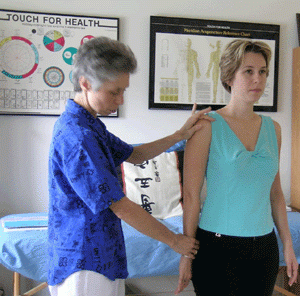The basis for kinesiology is the science of muscle testing. Muscle testing is a form of biofeedback. To perform muscle testing a particular muscle is held in it’s contracted state. Then slow, gentle, steady, pressure is used to move the muscle towards it’s normal range of motion. If the muscle easily holds or ‘locks’ it is considered to be giving a positive feedback response.
In Kinesiology we use muscle testing to determine the body’s response to many different types of stress that a person is dealing with, and which ones they are successfully handling. Muscle testing also allows us to identify ways to enhance or upgrade our response to stress. These can includes stress responses to physical, emotional, mental and spiritual aspects of our lives.
Muscle testing is both an art and a science. The techniques of how to achieve consistent, accurate muscle tests are learned best in a hands-on class. And like many other learned skills the ‘art’ of muscle testing takes practice to master.
 Touch For Health (TFH) is probably the simplest and easiest system of kinesiology. Developed by Dr. John Thie, TFH was intended for lay people to have a simple, powerful tool to help themselves, their families and friends.
Touch For Health (TFH) is probably the simplest and easiest system of kinesiology. Developed by Dr. John Thie, TFH was intended for lay people to have a simple, powerful tool to help themselves, their families and friends.Awareness of what we want (our goals) and being able to identify the blocks to achieve those goals is a key concept in the process of TFH. The means to achieving those goals is through balancing the body’s acupuncture energy system. This is done without using needles or the traditional Chinese acupuncture’s assessment called ‘reading the pulses’. TFH uses muscle testing to determine which meridians (or subtle energy pathways) are under energized.
When a meridian is found to be ‘under energy’ a number of different energy reflexes can be activated to restore the proper balance. These include:
- Neurolymphatic points- (Chapman reflexes) small specific reflexes on the body that are briefly rubbed (this can be done either by the person on their own reflex points or someone else rubbing them).
- Neurovascular points- (Bennett reflexes) specific places, mostly on the head, that are very lightly held without movement (this can also be done on oneself, or by having another person hold them.)
- Acupuncture holding points where specific acupuncture points in combination are gently held without pressure or movement to transfer energy.
- Meridian stroking where the energy 1-2 inches above the body is stroked following the meridian pathways.
- Bilateral reflexes- (Thie reflexes) specific spots on top of the spine that are rubbed to slightly stretch the skin.
- Nutrition and other interventions can also restore balance to the meridians
TFH also recognizes that each thought we hold impacts our energy system. In TFH we do ‘balances’ rather than treatments. When a balance is done with a goal in mind, it can reshape the energetic pattern we hold in relation to that goal. Balancing releases the reactive pattern associated with the stress and allows our inner resources to deal more successfully with issues in our lives
Detroit chiropractor Dr. George Goodheart discovered the field of Kinesiology and teaches a system called Applied Kinesiology. This system is taught exclusively to MDs and chiropractors. Dr Thie was one of the first dozen students of Dr. Goodheart and shortly afterwards created TFH. Many professionals trained in Applied Kinesiology and Touch For Health went on to use muscle testing in new creative applications. There are now dozens of specialized kinesiologies. Many have a specific focus on structural, educational, emotional, psychological, or spiritual balancing.
The ICPKP – International College of – definition of Kinesiology as taken from ICPKP website.
“Kinesiology is a communication tool that enables a person to assess and upgrade their performance in all areas of their life. Kinesiology is the science of energy balancing and is grounded in the study of anatomy and physiology. Kinesiology uses muscles as monitors of stress and imbalance within the body. Kinesiology enables people to detect and correct various imbalances that may relate to stress, nutrition, learning problems, minor injuries and other issues they meet in their daily life.”
“Kinesiology is a communication tool that enables a person to assess and upgrade their performance in all areas of their life. Kinesiology is the science of energy balancing and is grounded in the study of anatomy and physiology. Kinesiology uses muscles as monitors of stress and imbalance within the body. Kinesiology enables people to detect and correct various imbalances that may relate to stress, nutrition, learning problems, minor injuries and other issues they meet in their daily life.”
Statement from ICPKP website comparing Kinesiology to other health systems-
“Chiropractors manipulate the spine, Osteopaths do more subtle spinal adjustments, Physiotherapists and Massage Therapists work more directly on the muscles themselves. All these professions aim to relax the knotted-up muscle. Medical Doctors use pain relieving drugs or anti-inflammatory medication (NSAIDs) to relieve the inflammatory process in the knotted-up muscle. Only kinesiologists and acupuncturists work from the perspective that knotted-up muscles relate to imbalances in body energy.”
Definition of Touch for Health Kinesiology: In Touch for Health we use muscle testing as a method of body biofeedback to identify imbalances in the body’s energy system. Using a systematic, holistic approach that includes energetic touch reflexes, emotions, nutrition and intention, the Touch for Health process rebalance the body’s energies and activates the body’s intrinsic healing process so that the body can better heal itself. – Arlene Green
